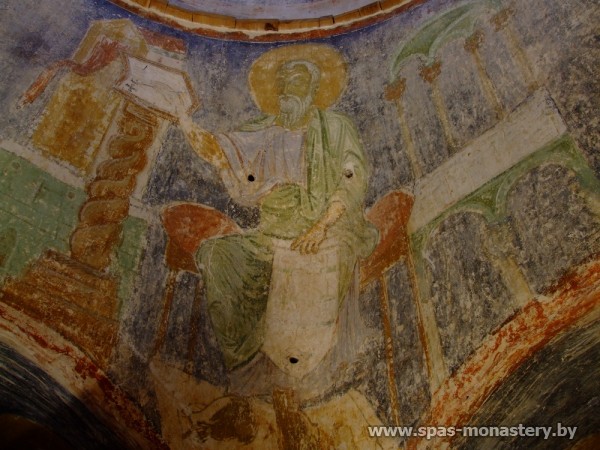
Few people know that there is only one historical site on the territory of modern Belarus where 12th-century frescoes have been preserved: the Transfiguration Church of St. Euphrosyne Monastery in Polotsk. In Russia, only frescoes of the Mirozh Monastery in Pskov have similar degree of intactness.
These frescoes have been renewed and repainted more than once – the last time in the 19th century they were repainted with oil paints. Only in the 1990s did the restoration and renewal of ancient paintings begin, with the oil paintings being transferred to a new surface and preserved as a portable exposition.

The church is painted in the Byzantine style, using natural paints on wet plaster. This helped to preserve them for many centuries. The iconographic themes are traditional for their time, but with some features that become clearer if you place them in the context of the era in which they were created. There was a new wave of theological disputes in the middle of the 12th century regarding the union of divine and human natures in Christ.
When the veneration of icons was restored, there was a tradition to depict the Pantocrator in the dome. However, in the Mirozh Monastery Cathedral and in the Holy Savior Church in Polotsk there is the icon of the Ascension in the dome. The Almighty One is portrayed seated on a rainbow, the mandorla surrounding his figure is supported by four angels, while the Mother of God, accompanied by two archangels, and the twelve apostles watching the ascending Christ are located at the bottom of the composition. Whereas in the early Christian memorials the Ascension marked first of all the Second Coming, in the mid-12th century the fact of Christ’s Ascension in the flesh becomes more relevant, as it confirms the triumph of the unification of the divine and human natures in Christ.

It is also worth noting that the paintings of the church pay special attention to the theme of healing. There are several scenes such as “The Healing of the Leper”, “The Healing of the Blind” on the pillars, “The Healing of Emperor Constance by St. Spyridon of Trimythous” (located in the altar apse), as well as numerous figures of healers: the martyrs Cyrus, John, Ermolaus and several other holy doctors.
The murals of the Holy Transfiguration Church contain some images of monasticism that are absolutely unique for their time in terms of completeness and diversity of interpretation. Given that the church was part of a convent, it was probably at the request of St. Euphrosyne herself that the theme of monastic service became the main subject of the murals in the church. This is a very rare extended iconographic program, featuring a large number of monastic images.

In the lower area of the murals of the northern and southern walls there are two subjects unique to their time, usually called The Sources of Wisdom or The Teaching of the Holy Fathers.
The scene on the southern wall depicts St. John Chrysostom, who sits behind a lectern and writes in an open book. The Apostle Paul stands behind him, dictating in his ear, and Saint Proclus, the cell attendant of the holy hierarch, is watching what is happening from behind the curtain, in the left part of the composition, inside the architectural wing that represents the entrance to the cell of Saint John.

The Polotsk fresco is significantly expanded: there is a group of monks in front of St. John who are listening to his teachings, and there is a water stream running from under the lectern. There are two figures who drink from the spring at the right side of the wall. In contrast, a similar composition with another Source of Wisdom, where the main character is St. Gregory the Theologian receiving an instruction from the Apostle John, is almost entirely preserved on the northern wall.
Frescoes of the Holy Transfiguration Church have certain differences, which is primarily due to the fact that several painters were involved in the painting of the church. Their individuality was especially pronounced in the way they painted faces. Thus, the faces of Christ and the Apostles in the Eucharist are distinguished by their strong commitment to classical designs; one can feel in their proportions the balance that was characteristic of the Constantinopolitan artists.

Ancient painters mainly used a system of contrasting color combinations, using a variety of mixed colors, strongly accentuated with large additions of white lime paint. Meanwhile, the background was intense and saturated due to the traditional two-stage painting technique, when the bottom layer, the so-called primer, was applied directly to the raw plaster, while the upper layer of bright blue paint made of natural lapis lazuli, was applied on top of the almost dry primer as a thin velvety layer.
Restoration works are not finished yet. Not all of the frescoes are exposed yet, but as we uncover more and more frescoes, we are increasingly surprised at their condition, elaborate design, and artistic excellence.



Photos: http://spas-monastery.by/



